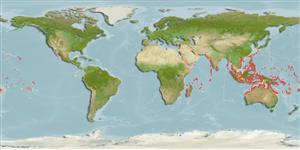Common names from other countries
Environment: milieu / climate zone / depth range / distribution range
Ecologia
marino associati a barriera corallina; distribuzione batimetrica 4 - 30 m (Ref. 9710). Tropical; 35°N - 28°S
Indo-Pacific: East Africa south to Natal, South Africa (Ref. 4919) and east to Samoa, northward to the Ryukyus and western sea of Japan, southward to New Caledonia and Queensland, Australia.
Size / Peso / Age
Maturity: Lm ? range ? - ? cm
Max length : 65.0 cm TL maschio/sesso non determinato; (Ref. 9710)
Spine dorsali (totale) : 0; Raggi dorsali molli (totale) : 11 - 12; Spine anali: 0; Raggi anali molli: 10 - 11. Body covered with prickles (Ref. 559). Body beautifully colored; black area around anus, black reticulations below pectoral fins (Ref. 4919).
Occur in clear lagoon and sheltered seaward reefs (Ref. 9710). Solitary (Ref. 90102). Adults usually along deep drop-offs (Ref. 48637). Usually close to shelter. Occur singly (Ref. 9710). Feed on algae, sponges, and benthic invertebrates.
Life cycle and mating behavior
Maturities | Riproduzione | Spawnings | Egg(s) | Fecundities | Larve
Myers, R.F., 1991. Micronesian reef fishes. Second Ed. Coral Graphics, Barrigada, Guam. 298 p. (Ref. 1602)
IUCN Red List Status (Ref. 130435)
CITES (Ref. 128078)
Not Evaluated
Threat to humans
Poisonous to eat (Ref. 393)
Human uses
Pesca: scarso interesse commerciale
Strumenti
Special reports
Download XML
Fonti Internet
Estimates based on models
Preferred temperature (Ref.
115969): 25.4 - 29.3, mean 28.5 (based on 2935 cells).
Phylogenetic diversity index (Ref.
82804): PD
50 = 0.5000 [Uniqueness, from 0.5 = low to 2.0 = high].
Bayesian length-weight: a=0.03715 (0.01569 - 0.08798), b=2.87 (2.70 - 3.04), in cm Total Length, based on LWR estimates for this Genus-body shape (Ref.
93245).
Trophic level (Ref.
69278): 2.8 ±0.19 se; based on food items.
Resilienza (Ref.
120179): Medio, tempo minimo di raddoppiamento della popolazione 1.4 - 4.4 anni (Preliminary K or Fecundity.).
Fishing Vulnerability (Ref.
59153): Moderate to high vulnerability (46 of 100).
